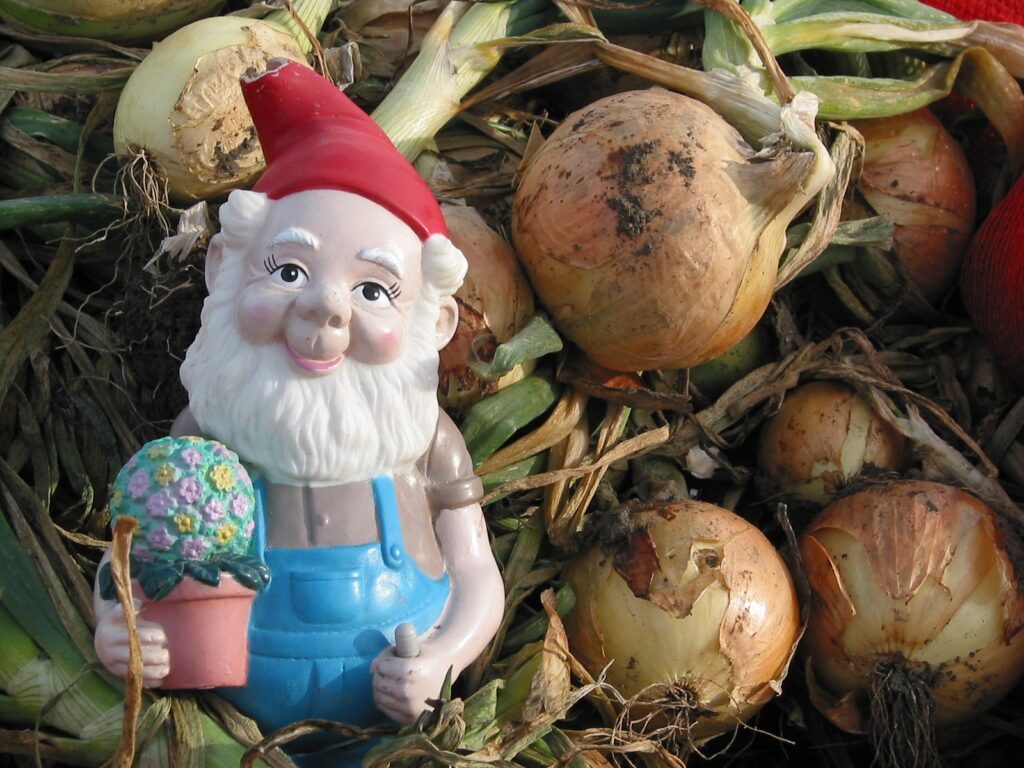
by Jackie Bantle
Saskatchewan Perennial Society
Although you may have been harvesting onions and potatoes since summer, fall is the time to harvest these two crops for long term storage.
All onions should be harvested and removed from the garden prior to the first fall frost. Onion bulbs will freeze below 0°C.
By early September, onion plants have started to mature: leaves start to turn yellow and fall over. Collapsing onion leaves at the end of the growing season indicate that the plant is shutting down and the onions are maturing. Onion bulbs whose leaves have not fallen over naturally at the end of the season will not store as long as those onion bulbs whose leaves have fallen over. A gardener can aid the process by gently stomping on onion leaves so that they fall over and form an abscission layer which will aid in the curing process. Do not stomp onion leaves prior to September!
After tops have fallen over, pull onions out of the soil and let the bulbs (attached to the tops) dry in a warm dry location for two to three days. This is known as curing. Curing can be done directly on the dry garden soil for several days in the sun as long as there are no heavy dews or rain. An empty greenhouse bench or hanging over a fence also works for curing onion bulbs. When harvesting bulbs from the soil, take care not to damage any of the bulbs.
After curing, cut off onion tops where the leaves have collapsed (i.e. the abscission layer); approximately 2.5-5cm above the bulb. Move onions into a warm dry location (20°C) and store for at least one week prior to long term storage: this is also part of the curing process. Ideal long term storage for onions is between 0-5°C and 65-70% relative humidity. Onions can be stored under warmer and drier conditions however, sprouting and moisture loss will be hastened.

It is unlikely that Spanish onions will reach full maturity prior to harvest time at northern latitudes. For this reason, Spanish onions do not store well. Follow the same directions for harvest and curing as with storage onions however, use Spanish onions within one or two months of harvest for best results.
Potatoes can be harvested as soon as the tubers reach the desirable size for eating. This can be as early as mid-July. Potato tubers that are harvested from a plant that still has green leaves will have a soft outer skin. These potato tubers have not been cured and will not store for a long period of time. To harvest potato tubers for long-term storage, remove the potato tops at least one week prior to harvesting: this encourages good skin set on the tubers. Good skin set ensures that the tubers will resist dehydration and disease during subsequent storage. If the tops have been frozen or have senesced naturally prior to harvest there is no need to remove the tops prior to harvesting. Potato tubers in the soil do not need to be harvested prior to fall frosts of 0°C to -3°C. Once night temperatures start to reach -4°C or lower, potato tubers (especially near the soil surface) may start to freeze. Frozen potato tubers do not store. When harvesting potatoes, carefully dig around the underground tubers with a digging fork or spade. Take care not to damage tubers as damaged tubers do not store well. Carefully remove excess soil from the tubers, do not wash potatoes. Do not allow potatoes to dry or ‘cure’ in the hot sun: move freshly harvested tubers to a dark, dry, cool location (ie. a root cellar is perfect).
Ideal long term storage conditions for potatoes are about 4˚C and 90-95% humidity with regular air exchanges. Black spots in the potato flesh indicate a lack of oxygen to the tuber tissues, resulting in cell death. Tubers exposed to flooding during growth or insufficient air exchange/oxygen supply during storage commonly show this disorder. Do not store apples next to potatoes. The ethylene from the apples will cause the potatoes to sprout.
Happy harvesting!
This column is provided courtesy of the Saskatchewan Perennial Society (SPS; saskperennial@hotmail.com ). Check our website saskperennial.ca) or Facebook page (facebook.com/saskperennial). All Saskatchewan Perennial Society events are on hold until further notice.

